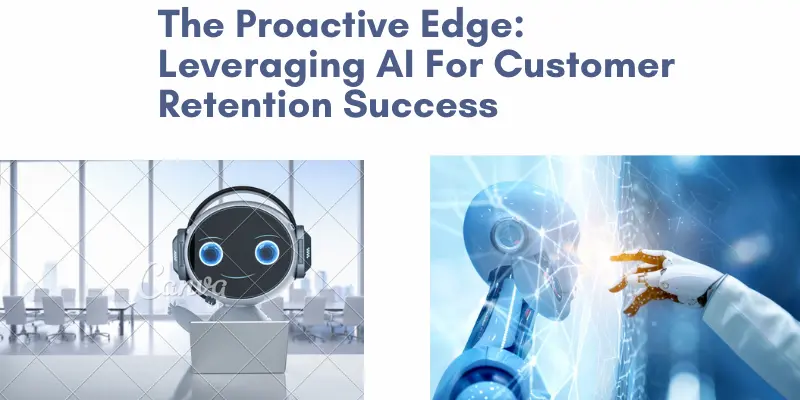AI for Customer Retention – Boost Loyalty, Slash Churn & Skyrocket Revenue
Published: 02 Jun 2025
In my experience working with subscription businesses, one thing is clear — AI for Customer Retention has become the North Star metric. It’s not just about keeping customers anymore; it’s about driving profitability and long-term growth. Especially during an economic downturn, retaining loyal users can be more valuable than gaining new ones. A recent Global Customer Loyalty report reveals that an increasing number of customer-facing companies are prioritizing investment in retention over acquisition, which makes perfect sense. Traditional retention strategies often lack precision, and many fall short of creating real impact.

That’s where AI comes in, not as a replacement, but as an upgrade. By using artificial intelligence and cutting-edge technologies, businesses can take a proactive, customer-centric approach to challenges. AI doesn’t just react; it predicts behavior, unlocks new opportunities, and helps reshape how we think about revenue and loyalty. With the transformative potential of machine learning and data analysis, AI-powered retention strategies can personalize customer experiences and adapt in real time, something old systems simply can’t do. In short, if your goal is to survive and thrive, now’s the time to go all-in on AI-driven retention.
Why the Old Way Doesn’t Work Anymore
In my years working with fast-growing brands, I’ve seen how businesses tend to act only when customers show clear signs of dissatisfaction, like calling to cancel or skipping payments. This traditional method might seem practical, but it leaves too much to chance.

It gives limited visibility into real churn risk and often overlooks the build-up of negative experiences that slowly lead to cancellation. I once helped a startup that only flagged at-risk users after non-renewal of their subscriptions, but it was always too late.
Instead of reacting at the last minute, companies need to understand that churn is not sudden- it’s often the outcome of accumulated frustration. When I introduced early alert systems for that same startup, it was eye-opening how many quiet signals we had missed. To truly improve customer retention, we must go beyond the visible and rethink our entire approach. The old playbook no longer fits today’s dynamic user expectations.
The Proactive Edge: Leveraging AI For Customer Retention Success
In my experience working with subscription businesses, I’ve seen how quickly dissatisfaction can snowball into negative experiences that lead customers to cancel. The mistake many companies make is relying on outdated customer retention strategies that only respond when red flags – like complaints or missed renewals – show up.

What’s missing is a life-cycle-based approach – an early, proactive system that detects subtle signs like changing behaviors, reduced engagement, or shifts in sentiment analysis before these issues escalate. This is where AI-powered customer retention solutions deliver real value.
With AI, businesses can proactively analyze the full customer journey, identifying behavior patterns that indicate churn risk. Instead of reacting too late, companies can improve customer retention by building predictive scores and churn profiles based on real-time data. This approach allows assigning a risk score to each user and deploying targeted retention strategies like tailored incentives or priority support based on what truly drives them away. At the same time, exploring which type of AI chatbot is best for your customer service can further enhance retention by ensuring customers receive timely, intelligent, and personalized interactions at every touchpoint.
These smart actions do more than improve customer retention metrics – they strengthen loyalty, boost satisfaction, and open new growth opportunities such as upselling, winning back lapsed users, or encouraging referrals. In today’s competitive market, AI-driven customer retention means more than just preventing churn – it enables you to exceed expectations, increase NPS, and create meaningful customer relationships that last.
Conclusion
In today’s fast-changing world, subscription businesses need to stay one step ahead to hold on to their customers. From my own experience working with growing digital platforms, leveraging AI for Customer Retention has become a real game-changer. Smart AI-driven tools not only help companies keep customers but also build deeper, more meaningful relationships. These strategies don’t just stop churn—they actively drive profitability by giving brands a clearer understanding of what their users truly want. And when you understand your audience, loyalty naturally follows.
What makes this powerful is how machine learning and algorithms analyze vast amounts of customer data to predict behaviors like churn or dissatisfaction. With AI for Customer Retention, businesses can act early, send tailored messages, and personalize their approach to stop losses before they happen. This isn’t just problem-solving—it’s proactive growth. The result? Lower attrition, stronger loyalty, and a proven way to thrive in competitive markets. From what I’ve seen, this shift doesn’t just work—it transforms retention into a long-term growth engine.
FAQs:AI for Customer Retention
There are three common types: predictive analytics, machine learning, and natural language processing (NLP). Predictive analytics helps guess which customers might leave, machine learning finds patterns in behavior, and NLP understands customer feedback. Together, they make customer retention smarter.
Predictive analytics uses historical data to make future guesses, like which customers are likely to cancel. Machine learning does something similar but keeps learning and improving over time without being told what to do. Think of predictive analytics as a snapshot, and machine learning as a system that keeps updating.
Natural Language Processing (NLP) helps AI understand human language in emails, chats, or reviews. It picks up emotions like frustration or happiness, which can help spot unhappy customers early. This way, companies can act before people leave.
Not always. Some systems need human help to set up rules, monitor outcomes, or adjust strategies. Over time, as the AI learns, it can do more on its own.
This can happen if the data is outdated or not detailed enough. AI needs high-quality, recent data to make accurate predictions. Try updating your customer data and retraining the model.
Yes! AI can analyze customer habits and preferences to suggest personalized retention offers like discounts, upgrades, or helpful content. These offers are more effective than generic ones.
A churn risk score tells you how likely a customer is to leave. It’s based on things like activity level, complaints, or time since last purchase. AI calculates it by studying patterns from past customer behavior.
More data usually means better results. AI learns from patterns in data, so if you only have a little, the results might be less accurate. Start small, and as you gather more data, your AI will improve.
AI can detect early red flags and suggest next steps, like sending an apology email or alerting support staff. But for very angry or complex issues, human help is still best. AI supports, not replaces, your team.
It could be that the AI is not targeting the right drivers of dissatisfaction or is sending the wrong offers. Make sure you’re regularly reviewing AI insights and testing different personalized retention actions. AI works best when it’s always improving based on real feedback.

- Be Respectful
- Stay Relevant
- Stay Positive
- True Feedback
- Encourage Discussion
- Avoid Spamming
- No Fake News
- Don't Copy-Paste
- No Personal Attacks

- Be Respectful
- Stay Relevant
- Stay Positive
- True Feedback
- Encourage Discussion
- Avoid Spamming
- No Fake News
- Don't Copy-Paste
- No Personal Attacks





